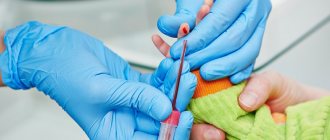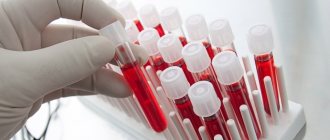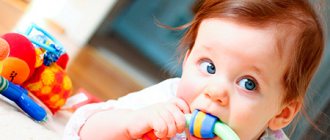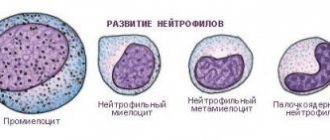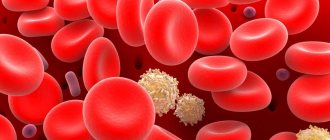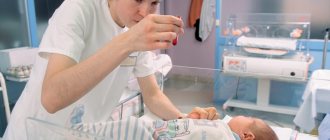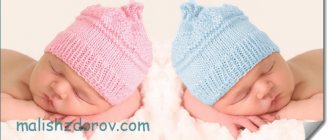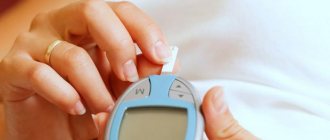Why does the body need eosinophils?
Each cell of our body plays its role. Now we will talk about eosinophils.
What are eosinophils?
Everyone knows that in our body there are erythrocytes (red blood cells) and leukocytes (white blood cells).
But few people know that leukocytes are also divided into:
- cells containing granules in the cytoplasm. These include basophils, neutrophils, eosinophils;
- cells that do not contain granules in the cytoplasm. Representatives of this group are monocytes and lymphocytes.
Thus, eosinophils are a type of leukocyte that contains granules. What kind of granules are these? These granules are found in the cytoplasm. Therefore, when staining cells, they are the ones that give eosinophils their bright red color.
What do eosinophil granules contain? Eosinophils contain a number of substances that ensure the performance of their functions. These include:
- main basic protein - promotes the destruction of parasites due to its toxic effect;
- cationic protein of eosinophils - also has toxic activity towards helminths, suppresses the synthesis of antibodies, helps in interaction with other cells;
- eosinophilic peroxidase – promotes the oxidation of substances, which results in the formation of reactive oxygen species. They, in turn, are capable of exposing the cell to death;
- eosinophil neurotoxin - exhibits its activity against viruses, activating cells of the immune system to develop an inflammatory response.
In addition to the fact that eosinophils have specific granules, these cells are capable of producing various signaling molecules. They are called cytokines. They ensure the functioning of cytokines at the site of inflammation and participation in the activation of the immune system.
Place of synthesis
All blood cells mature in the bone marrow. There, from the universal precursor cell, eosinophil maturation occurs (Figure 1).
Fig.1. Scheme of eosinophil maturation.
A mature cell, a segmented eosinophil, enters the bloodstream. If young forms are detected in the blood, this may indicate excessive destruction of eosinophils or the receipt of a large number of signals in the bone marrow to stimulate the formation of these cells.
A signal came to the bone marrow about the need for the synthesis of eosinophils, and after 4 days these cells are waiting for their turn to enter the bloodstream.
Eosinophils circulate in the blood for only a few hours, after which they go into the tissues and stand guard over order. They remain in tissues for about 10–12 days.
A small number of eosinophils are found in tissues that border the environment, providing protection to our body.
What functions do eosinophils perform?
It has already been said before what effects eosinophils can perform due to specific granules in the cytoplasm. But in order for eosinophils to be activated, that is, to release the contents of the granules, some kind of signal is required. Basically, this signal is the interaction of activators with receptors on the surface of eosinophils.
The activator can be antibodies of classes E and G, the complement system activated by helminth components. In addition to directly interacting with the surface of eosinophils, mast cells, for example, can produce chemotaxis factor, a compound that attracts eosinophils to that site.
Based on this, the functions of eosinophils include:
- participation in an allergic reaction. During an allergic reaction, histamine is released from basophils and mast cells, which determines the clinical symptoms of hypersensitivity. Eosinophils migrate to this area and promote the breakdown of histamine;
- toxic effect. This biological effect can manifest itself in relation to helminths, pathogenic agents, etc.;
- possessing phagocytic activity, they are able to destroy pathological cells, but neutrophils have a higher ability;
- Due to the formation of reactive oxygen species, they exhibit their bactericidal effect.
The main thing to remember is that eosinophils are involved in allergic reactions and the fight against helminths.
Indications for determining the level of eosinophils in the blood
Since eosinophils play an important role in allergic reactions and the fight against parasites, it is advisable to determine the level of these cells in the blood if these processes are suspected.
That is, the main indications for determining the level of eosinophils in a child’s blood may be:
- after eating some food product, itching began, dermatitis appeared on the skin, damage to the respiratory tract (coughing, sneezing, swelling of the larynx), and so on;
- headaches, poor perseverance of the child, insomnia may indicate the presence of parasites;
- low body weight with increased appetite may also indicate helminthiasis;
- the process of digesting food is disrupted, accompanied by changes in stool, vomiting;
- stomach ache;
- signs of deficiency of essential nutrients, despite adequate feeding of the child;
- Body temperature may rise.
If your child is crying, then something is bothering him, but he cannot tell you about it. Therefore, it is extremely important to understand what is happening to it and prevent the development of serious complications.
In addition to food allergies, it is possible to develop hypersensitivity to dust, animal hair, pollen, and even medications.
How to take the test correctly?
In order for the analysis result to be accurate and truly reflect what is happening in our body, we need to be properly prepared. Moreover, there is nothing complicated in preparing for this analysis.
First of all, both parents and the child need to prepare mentally. It is best for the child not to cry, not to panic, and to behave calmly. To do this, parents should explain to the baby what will happen in the hospital, that there is nothing wrong with it. Maybe you can even promise your child something in return if he behaves well.
It is also important to prevent your child from running around the hospital corridors while waiting for their turn in the blood collection room. Physical activity may affect study results.
Also, one of the most important rules for preparing for a blood test is that it must be taken on an empty stomach. If the child is already big (over 4 years old), then you can be patient and donate blood after an overnight fast. It is allowed to give the child water to drink.
It is recommended not to feed infants for 1 - 1.5 days before donating blood.
Blood is most often taken from the finger; in very small children, from the heel.
When preparing to donate blood, it is important to take prescribed medications. A number of medications can affect test results. Therefore, it is advisable to talk to your doctor about this. Don't do anything on your own!
Some medications can affect the level of the determined indicator. For example, Prednisolone can lead to a decrease in the level of eosinophils and monocytes in the blood.
If parents properly prepare for donating blood, they will not have to take the test again, plunging their child into a stressful situation.
How is it determined in children?
The number of eosinophils is determined during a general blood test. The biomaterial is collected from a finger. You need to donate blood in the morning on an empty stomach. The last meal should be taken at least 12 hours before visiting the laboratory. Drinking liquid is allowed.
The number of eosinophils is compared with the number of other blood cells, on the basis of which a conclusion is made about the possible presence of the disease. Reduced eosinophils are not typical signs of pathology, so the child should be carefully examined.
Interpretation of results
The interpretation of the results should be carried out by the attending physician who referred your child for a blood test. If the parents independently asked for a blood test, then deciphering the answer should be entrusted to a specialist. It may be located in the same place where the blood was donated, or you can contact your place of residence with a ready-made test result.
When eosinophils are elevated in a child and in an adult, this condition is called eosinophilia. Next we will look at situations where this is possible and why it occurs.
Norm and deviations
The absolute number of eosinophilic granulocytes in children under 12 years of age should be 20-600 million/l. After 12 years, this figure approaches the norm for an adult and amounts to 20-440 million/l. The proportion of eosinophils in the number of leukocytes in a child should be 0.5-7%. Values outside this range are considered deviations.
When calculating the percentage, 100 leukocytes are viewed, most of which are represented by lymphocytes and neutrophils. There may be few eosinophils in a blood sample. In some pathological conditions, the indicator tends to 0. This means that among 100 white blood cells not a single eosinophilic granulocyte was found. When a zero is obtained as a result of analysis, we are not talking about the complete disappearance of some elements. When examining the next batch of leukocytes, eosinophils may be detected.
Important information: What do low leukocytes mean in a blood test in women (reasons for low levels)
Why are eosinophils in a child’s blood elevated?
There are a number of conditions when eosinophils are elevated in the blood.
- A worm entered the body, that is, helminthiasis occurred. Eosinophils migrate to the lesion, trying to get rid of the unwanted “guest”, thereby increasing their number in the blood. The most common parasites in children are pinworms and roundworms.
- Allergic reactions. In response to the penetration of an allergen into the child’s body, an immune reaction develops, during which various cells are activated. These include eosinophils. As mentioned earlier, they help break down histamine, an allergy substance. In order to confirm the presence of an allergic reaction, the level of eosinophils in the blood is determined. If the allergy is confirmed, they move on to searching for what could have caused it.
- Allergic diseases. This group includes pathologies such as bronchial asthma, hay fever and others. They are already “fixed” in the body, they are more difficult to get rid of than simple allergies.
- Hypersensitivity to drugs. It usually occurs immediately after administration of the drug. Such people then have to mention this throughout their lives when contacting a medical organization.
- Lefler's syndrome. This pathology is associated with the formation of an infiltrate in the lungs, which can be seen during a chest x-ray. In parallel, there is a high level of eosinophils in the blood. However, this pathology is very rare, most often in older people.
- Hypereosinophilic syndrome. This condition is accompanied by an excess amount of eosinophils in the blood and damage to the corresponding tissues. No parasites or allergic diseases are detected in the patient. What causes this condition remains unknown.
- Pathology of connective tissue. This includes: vasculitis, systemic lupus erythematosus, scleroderma and others. An increased level of eosinophils indicates the presence of a developing inflammatory process.
- Malignant neoplasms , for example, leukemia, can lead to eosinophilia.
- Polycythemia is accompanied by an increase in all blood cells, eosinophils are no exception. Diagnosing this disease is not difficult.
- Acute bacterial infections , infectious mononucleosis, tuberculosis can cause an increase in the level of eosinophils in the blood.
Eosinophils are elevated in a child: 10 reasons for the increase, 7 indications for analysis
: Not rated
Having received the results of a clinical blood test, each parent rushes to find out for themselves whether everything is in order. It’s great if all the indicators are within the normal range, but it happens that the result goes beyond its limits. Incomprehensible names of blood components can greatly frighten inexperienced mothers and fathers.
And what is most alarming is the factor that caused the deviation from the norm. If the analysis form shows elevated eosinophils in the child’s blood, first of all, you need to find out the reasons for this result. To do this, it is important to understand the functions of this type of cell, the reasons for their increase in number and other symptoms of diseases associated with eosinophilia.
Purpose of eosinophils
First of all, it should be noted that eosinophils are one of nine types of leukocytes - cells that guard the immune system.
They recognize invading pathogens and stimulate immune responses. The effect of eosinophils is manifested in a cytotoxic reaction to parasites.
A deviation from the norm of this indicator also indicates that the body perceives something as an allergen.
A change in the number of eosinophils in the results of a CBC indicates that there is an imbalance between the process of hematopoiesis in the bone marrow, the migration of blood cells and their breakdown in the tissues of the body.
Indicators indicating an increase in level
For different ages, the norm of eosinophils in the blood of children will also be different. Compared to adults, their number is slightly higher in children, since the child’s immunity is just developing. Normal laboratory values are as follows:
- In newborns – 1-6
- In children under two weeks of age – 1-6
- From two weeks to one year – 1-5
- From one to two years – 1-7
- From two to five years – 1-6
- From six to sixteen years old – 1-5
If the indicators are higher, then this condition is called eosinophilia. It’s not very good when the analysis showed low eosinophils in the child’s blood. This may signal the initial stage of inflammation, a stressful condition, a purulent infection, or poisoning with any heavy metals or chemicals.
There can be quite a few reasons for the increase in the number of this type of leukocytes in the baby’s body, for example:
- Increasing the body's sensitivity to exogenous or endogenous antigens. In this case, it can be provoked by bronchial asthma, hay fever, allergic rhinitis, eosinophilic granulomatosis with polyangiitis, skin and food allergic reactions.
- Allergy to medications. For example, penicillins, tetracyclines, sulfonamides, aspirin, chloramphenicol, aminophylline and similar drugs.
- Some skin diseases.
- Infestation with parasites. Most often these are Giardia, Ascaris, Echinococcus larvae, Trichinella, liver fluke and others.
- Acute manifestations of infectious diseases such as chickenpox, tuberculosis, scarlet fever, gonorrhea, infectious mononucleosis.
- Malignant neoplasms.
- Proliferative diseases of the blood system - lymphoma, acute and chronic leukemia, lymphogranulomatosis, hypereosinophilic syndrome, polycythemia, and others.
- Inflammations in the connective tissue, such as rheumatoid arthritis or polyarteritis nodosa, as well as systemic scleroderma.
- Lung diseases - eosinophilic pleurisy, eosinophilic pneumonia, sarcoidosis, Langerhans cell histiocytosis, pulmonary eosinophilic infiltrate (Leffler's disease).
Symptoms of the disease
Since there are many reasons for an increase in eosinophils in a child’s blood, the symptoms may be different.
When infected with parasites, the symptoms are usually nonspecific and may be overlooked or mistaken for signs of another disease. Reasons to suspect a parasitic infestation are as follows:
- Changes in appetite occur;
- Feeling lethargic and lack of strength;
- Itchy irritation of the anus occurs;
- Weight decreases;
- Muscle pain appears;
- Allergic reactions appear on the skin.
If the cause of the increase in leukocytes in the blood is a reaction to an allergen, then the symptoms will correspond to allergic diseases:
- Skin rash accompanied by itching;
- Runny nose, sneezing, swelling;
- Dry cough, difficulty breathing, asthma attacks;
- Itching, redness of the eyes, watery eyes.
Other diseases in which an increase in the number of this type of leukocytes is possible are more typical for adults. However, any changes in the child’s condition, along with a deviation from the norm as a result of the study, and especially when eosinophils are elevated in an infant, require additional attention from specialists.
Useful tips
Concern for the child pushes parents to seek additional examinations. To get a more accurate result, you should follow some rules for taking a clinical blood test:
- Since an increase in leukocytes follows after eating, it is best to donate blood on an empty stomach;
- Theoretically, the indicators also depend on the time of day at which the analysis was done, so it is preferable to do it in the morning;
- If the OAC is taken several times during the course of an illness, then it would be correct to observe the same conditions (for example, always in the morning and before meals) so that the indicators are affected by as few factors as possible;
- If the child is healthy and eosinophilia persists for a long time, it is worth taking a test for the level of total immunoglobulin E to determine the tendency to allergic reactions.
Dr. Komarovsky says the following about the increase in eosinophils in a child: “it can be present after illnesses, usually bacterial, at the stage of recovery. But if the child’s general condition is normal, then the increase in the number of eosinophils in itself should not cause concern in parents.
If the child is healthy, then it is best to monitor his condition and be examined (do an OAC) after about 3-4 months.
Any discrepancy with normal values as a result of the OAC is very worrying for parents. To dispel groundless worries, you need to understand what this analysis is all about, what data it can report and what to do when a deviation from the norm is detected.
In this video, Dr. Komarovsky will help parents navigate the complex names of blood cells and understand their purpose, as well as determine the type of disease indicated by changes in indicators.
The state of the blood can tell a lot about the health of the baby. What “enemy” has entered the body, at what stage of the fight, and much more.
When the analysis reveals elevated monocytes and eosinophils in a child, this signals a fight of the immune system against foreign objects.
To alleviate the course of the disease and prevent the occurrence of diseases in the future, you need to constantly work to strengthen the child’s immunity. Have you encountered an increase in the number of eosinophils in children and what disease was this indicator a signal of?
Source:
What do elevated eosinophils mean in a blood test in adults?
The materials are published for informational purposes only and are not a prescription for treatment! We recommend that you consult a hematologist at your medical institution!
Co-authors: Natalya Viktorovna Markovets, hematologist
Eosinophils are a type of white blood cell stained with the acidic pigment eosin.
What are eosinophils in a blood test and what function do they perform? These are segmented formations that can leak through the walls of blood vessels and move inside tissues, heading towards the site of inflammation, injury or the introduction of a foreign agent. An increase in their level in a blood test is an alarming signal.
- Eosinophilia and its causes
- Indications for donating blood
- Treatment methods
Eosinophils are elevated when the body is attacked by parasites and during the development of allergic conditions. Eosinophils are formed in the bone marrow in response to foreign protein entering the body. The doctor learns that the patient's blood eosinophils are elevated when interpreting the results of a standard blood test.
Eosinophilia and its causes
Important! An increase in eosinophils is considered to be 7% of the total number of white cells. There is a mild form, in which tests show up to 10%. The average form is considered 10-15%, and everything above is considered severe.
When eosinophils are higher than normal, what does this mean? Definitely a pathological process occurring in the body.
Eosinophils in the blood
The reasons for the increase in eosinophils in an adult are associated with the following factors:
- Allergy. It is a clinical symptom of bronchial asthma and a number of dermatitis.
- Invasive pathologies - ascariasis, opisthorchiasis, giardiasis.
- Infectious diseases and pathologies of the digestive chain at the recovery stage.
- Cancerous tumors accompanied by tissue destruction. Eosinophils react to breakdown products as foreign proteins.
- Respiratory diseases.
- Myocardial infarction.
- Eosinophils are elevated in adults and children if certain medications are used. Antibiotics, salicylates, sulfonamides, iodates have an allergic effect on the body, which provokes eosinophilia.
- Food allergies. It develops when consuming certain, often seasonal, vegetables, berries, mushrooms, fish and seafood.
- Allergic conditions during pregnancy, during menstruation.
Important! Eating citrus fruits before donating blood for a standard test shows eosinophilia.
Allergies cause increased eosinophils
Actions of parents in case of eosinophilia in children
If elevated levels of eosinophils are detected, parents should consult a doctor. Since this is a “bell” that something is going wrong in the child’s body.
If it is confirmed that the child has a parasite, the doctor will prescribe medications to help remove it from the body. Do not drug your child without consulting a doctor!
If an allergic reaction is confirmed, it is important to identify its source. Then remove the child from contact with this allergen.
In general, in any case, consult a doctor, independence can aggravate the situation.
